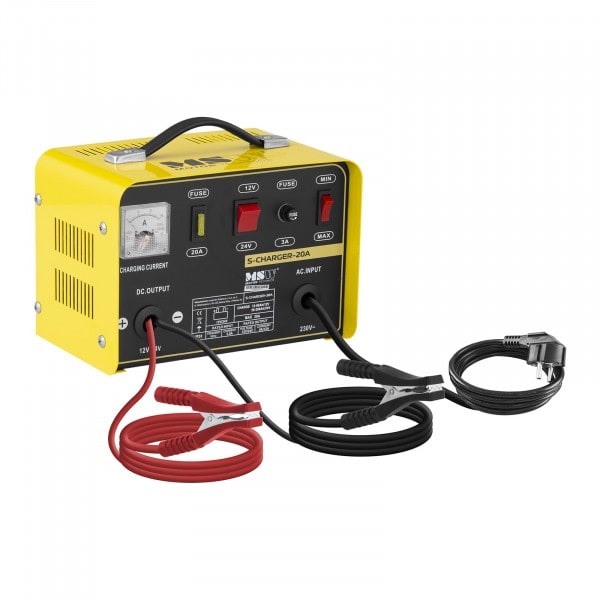Ever left your car lights on overnight and found yourself stuck with a dead battery in the morning? It’s a pain, right? When there’s no one around to jump-start your car, your only lifeline is a battery charger. Read on and we'll guide you to the perfect charger to revive your car battery and get back on the road.

Ever left your car lights on overnight and found yourself stuck with a dead battery in the morning? It’s a pain, right? When there’s no one around to jump-start your car, your only lifeline is a battery charger. Read on and we’ll guide you to the perfect charger to revive your car battery and get back on the road.
What is a car battery charger?
A dead car battery isn’t the end of the world. Like your phone battery, all it needs is the right car battery charger, and you’ll be back on the road in no time.
There are several types of chargers out there, which we’ll cover in this guide. They all share some key features. For starters, they convert AC power into DC power, which your battery needs to recharge.
Another thing they all have in common? Two cables with clamps at the ends – one red for the positive terminal, and one black for the negative. Simple as that.
Why you need a battery charger
If you’re thinking: “Do I really need a car battery charger?” The answer is: yes. A dead battery can catch you off guard at the worst possible time. Having a charger handy can save you a great deal of hassle.
After all, we’ve all been there – you’re in a rush, leave the headlights or radio on, and the next morning your battery is completely drained. Often, batteries die after hours of powering lights or other gadgets you forgot to switch off.
Another common culprit? Those freezing winter nights. Sudden temperature drops can sap your battery’s power overnight, especially if you park outside instead of in a garage.
Sometimes, the issue isn’t you at all. It could be a technical problem, like a faulty alternator that didn’t charge the battery properly during your drive. If that’s the case, get the alternator fixed before plugging in a charger.
Which car battery charger should I buy?
Before buying a car battery charger, narrow your options down to one type. You’ll find four main kinds on the market: standard, microprocessor, pulse, and traction chargers. Which one’s the right fit for you?
Standard charger (transformer)
Standard chargers, also known as transformer rectifiers, are simple and budget-friendly. However, they come with fewer features. You’ll need to manually adjust the settings and monitor the charging process. Plus, they don’t shut off automatically once the battery’s full, so you’ve got to keep an eye on them. They’re only compatible with lead-acid batteries, so bear that in mind.
Microprocessor chargers (automatic)
Microprocessor chargers take the guesswork out of charging. These smart devices automatically select the right parameters and can handle various types of batteries. They cost a bit more than transformer models, but the convenience is worth it.
The best part? Automatic chargers shut themselves off once the battery is fully charged, so there’s no need to hover over it. They also protect against short circuits, should you accidentally connect the cables the wrong way.
Pulse chargers
Looking for efficiency? Pulse chargers are your go-to, with up to 90% energy efficiency. They’re also super convenient – no need to remove the battery from your car. Plus, their built-in system voltage test ensures your car’s electronics stay safe from overload or overcharging.
Charger for traction batteries
Traction battery chargers are in a league of their own. These aren’t for your everyday car – they’re built for electric vehicles, forklifts, or other industrial equipment. They can handle the high voltage demands of these powerful batteries with ease.
If you’re running a workshop or dealing with electric vehicles, these chargers are essential. But for the average car owner, you probably won’t need one unless you’re making the leap to electric.
| Product |  Heavy Duty Battery Charger – 12/24 V – 8/12 A |  Car Battery Charger – 12 / 24 V – 27 A – with cable compartment |  Car Battery Charger – jump start – 12 / 24 V – 70 A – compact |
| Input Voltage | 230V / 50Hz | 230V / 50Hz | 230V / 50Hz |
| Output Voltage | 12/24V | 12/24V | 12/24V |
| Functions | Charging | Charging, Jump-start | Charging, Jump-start |
| Charging Current | 8/12A | 27A | 70A |
| Jump-start Current | – | – | 320A |
| Cable Length | 180 cm | 180 cm | 180 cm |
| Battery Type | Lead-Acid | Lead-Acid | Lead-Acid |
| Dimensions | 15.6 x 25 x 19 cm | 23.5 x 27 x 20 cm | 32 x 37 x 62 cm |
What to consider when buying a car battery charger
Not all chargers are created equal. They don’t just differ in charging speed, but their efficiency, and extra features. Here’s what you need to look for to make sure your charger is a perfect match for your car’s battery.
Voltage
Matching the charger’s output voltage to your battery’s rating is non-negotiable. It’s as simple as this: your charger’s voltage must match that of your battery. You’ll find chargers for 6V, 12V, and 24V batteries. Motorcycles? Usually 6V. Cars? Mostly 12V. Trucks? You guessed it, 24V.
Need versatility? Go for a charger that switches between voltage levels – a solid choice if you’ve got multiple vehicles or work in a professional garage.
Charging current
The charging current is like your charger’s speedometer – it tells you how fast it’ll juice up your battery. The golden rule? Your charger’s current should be around 1/10th of your battery’s capacity. For example, if your battery’s 50Ah, look for a charger with 5A output. Any less, and you’ll be waiting a lot longer than you’d like.
Jump-start function
Picture this: you’re stranded with a dead battery in the middle of nowhere. No neighbours, no jumper cables, just you and your car. What now? A charger with a jump-start function can be your lifesaver. It lets you get back on the road in minutes, all on your own.
But don’t overuse it – these chargers push a lot of power to kickstart your car, which over time can take a toll on your battery and electronics.
Dimensions, weight, and mobility
Big, heavy chargers might get the job done, but they can be a hassle to move around. Instead, look for lightweight, compact models that are easy to position near your car.
If you’re going for a larger charger, make sure it comes with wheels or sturdy handles – your back will thank you. Bonus points if it has hooks or cable compartments to keep things tidy and safe in your garage.
How long does it take to charge a car battery?
Charging a car battery isn’t an instant process, especially if it’s a larger one. Several factors influence how long it’ll take – the battery’s starting charge, the ambient temperature, and the charger’s output current all play a part.
Pro tip: Charge your battery somewhere warm, like a garage. Cold weather can slow down charging and even damage your battery. Set the current to 1/10th of the battery’s capacity (e.g., 5A for a 50Ah battery), and a fully drained battery should be good to go in about 10 hours.
If you’re using a transformer charger, remember to disconnect it manually after about 10 hours – these models don’t automatically stop and could overcharge your battery. For safety and reliability, go with a lower current. It’ll take longer, but it’s worth it.
Which charger is right for you?
Choosing the right car battery charger depends on your needs. Is it for your home garage or a professional workshop? Do you just need a basic transformer charger, or are you after a state-of-the-art microprocessor model? Make sure the charger’s current and voltage match your battery’s requirements, so you can charge safely and effectively.
If you’re into cars and dreaming of starting your own business, check out our guide on how to open a car repair workshop. You’ll find practical tips and ideas for turning your passion into profit.






Share